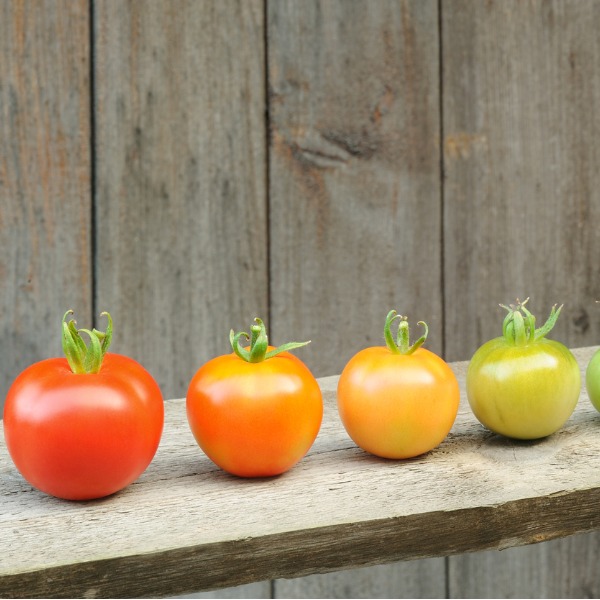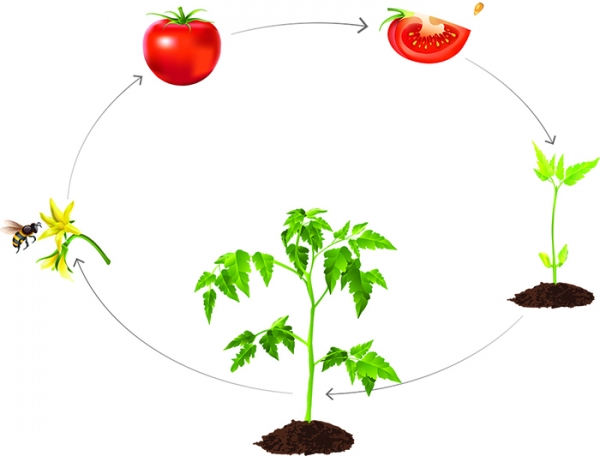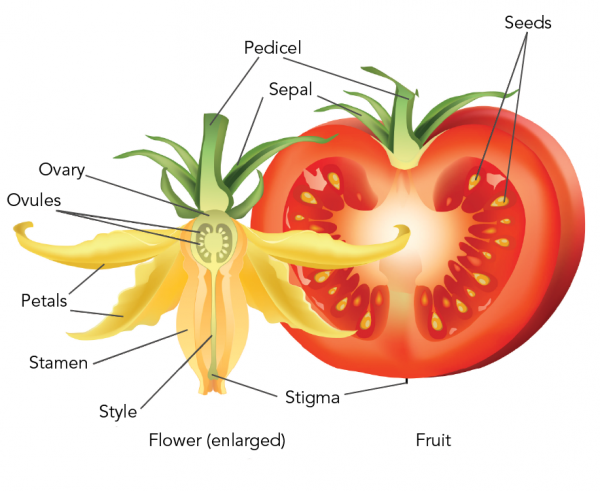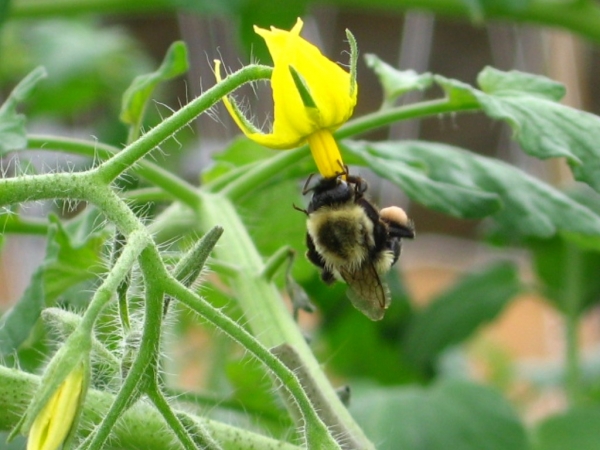The Life Cycle of a Tomato Plant

Maturation of tomato fruit (brozova, iStockphoto)

Maturation of tomato fruit (brozova, iStockphoto)
How does this align with my curriculum?
| Grade | Course | Topic |
|---|
Learn about the pollination, fertilization, germination and growth of tomato plants.
Reproduction
Tomatoes belong to a group of plants known as flowering plants, also called. The tomato plant reproduces sexually. This means that it needs both female and male organs to produce seeds.
Every tomato seed has a tiny tomato plant inside. When the conditions are just right, tomato seeds will germinate. When the seed, or young root breaks out of the seed and grows down into the ground., or seed leaves then grow up out of the ground towards the Sun. Soon the plant develops its first true leaves, then more leaves and flower buds. On mature tomato plants, flowers develop. This is where sexual reproduction occurs.

Image - Text Version
Shown is a colour illustration of a tomato plant at 5 stages in its life cycle, laid out in a circle.
On the top right is a tomato slice showing seeds inside, with one seed above it. This is labelled "Seed". A curved arrow points down and right to a thin, pale green plant with a few small leaves. This is labelled "Seedling". Another curved arrow points down and left to the bottom picture. This is a taller, darker green plant with more leaves. This is labelled "Mature Plant". Another curved arrow points up to the left-hand picture. This shows 2 yellow flowers on a green stem, with a bee hovering nearby. This is labelled "Flower". Another curved arrow points up and to the right, to the top left picture. This shows a whole, red, ripe tomato. This is labelled "Fruit". The last curved arrow points to the right, and leads back to the first picture, of the tomato slice.
Flower Structure
Flowers are important for reproduction and the production of seeds. A tomato flower is sometimes called a perfect flower because it has both male and female reproductive organs.

Image - Text Version
Shown is a full colour illustration labelled with the inside and outside parts of a tomato and its flower.
On the right is a red tomato cut in half to show many small yellow seeds in crescent-shaped structures inside. These are labelled "Seeds". There are green structures on the top centre of the tomato. The tallest structure, in the centre, is labelled "Pedicel".The outer structures are curved down. They are labelled "Sepal". On the left, the top of a yellow flower has similar green structures to the fruit. These are also labelled "Pedicel" and "Sepal". Curved yellow structures with scalloped edges, fan out from the centre of the flower. These are labelled "Petals". Inside the flower is visible. A round structure at the centre of the flower, near the top, is labelled "Ovary". Inside the ovary are 2 crescent-shaped structures labelled "Ovules". Below the ovary, a long yellow structure with curved sides is labelled "Stamen". Inside the stamen, a long, thin structure leads from the ovary to the bottom of the flower. This is labelled "Style". At the bottom end of the style, there is a small, round, green shape. This is labelled "Stigma". The stigma label also points to a spot at the centre bottom of the tomato fruit.
The tomato flower has four main parts:
- This part protects the bud before it opens. It is green and it is first visible when the bud forms. A attaches a flower to the main plant.
- This is the part of the flower that attracts insect. In tomato flowers, the petals are usually yellow.
- This is the male part of the flower. It usually has a long, slender with an at the top. The anther is covered with. Pollen contains the male genetic information. In tomato flowers, the stamens are fused together into a yellow, tube-shaped structure.
- This is the female part of the flower. It consists of the,, and. It is located at the centre of the flower, inside the tube of stamens.
The female reproductive organ is the ovary. It is located at the base of the pistil. The ovary contains. Once the ovules are fertilized, an can develop and form the seeds that will be found inside the tomato fruit.
Fruit Development
For flowers to develop into the tomato fruit that we eat, two things need to happen. These are pollination and fertilization.
Pollination
This is a process during which pollen, from the anthers, is placed onto the stigma. When wind moves the pollen, we call it wind pollination. When insects do the pollinating, we call it buzz pollination.
Buzz pollination occurs when a bee lands on a flower and vibrates its flight muscles. This can shake pollen loose from the anther. Some of these pollen grains may land in other flowers, resulting in pollination. Click here to learn about the importance of pollinators.

Image - Text Version
A colour photograph shows a bumblebee pollinating a tomato flower.
Green stems and leaves of a tomato plant fill the photograph. One yellow flower is in focus in the top centre. A large bumblebee grasps the stamen of the flower. It is a large, mainly black insect with a fuzzy yellow patch on its back.
Did you know?
Not all insects can buzz-pollinate. For example, bumblebees can pollinate tomato flowers, but honeybees can't. Honeybees also don't visit tomato flowers because they have no nectar to feed on.
Fertilization
This is the process in which male and female reproductive cells, called , combine. In animals, we call these gametes sperm and eggs. In plants the games are the pollen and ovules. The male and female gametes come together in the ovary to form a . The seed contains the embryo, , and . Once the seeds are formed, the tomato life cycle can begin all over again. Learn more about seeds in this backgrounder.
Fruit or Vegetable?
Is tomato a fruit or a vegetable? In cooking, tomato is considered a vegetable mostly because it is not sweet and not usually used in desserts. But in botany, tomato is a fruit. Fruit is defined as a part of a plant that develops from a flower’s ovary and has seeds. Since a tomato develops from its flower’s ovary and it has seeds inside, it is a fruit.
Learn More
Is tomato a fruit or vegetable? (2018)
This video (3:03 min.) from DreamWorks TV explores the confusion people have about fruits and vegetables.
A bumblebee buzz-pollinates a tomato flower (2016)
This video (0:23 min.) from PLOS Media shows a bumblebee buzz-pollinating tomato flowers.
Tomato plants from tomato slice (2018)
This time-lapse video (1:37 min.) from time-lapse shows tomato seeds as they germinate and grow into mature plants in under two minutes!
Flowering Principles (2003)
This web page from Don Lee & Kim Todd about the life cycle of flowering plants comes with graphics and quizzes.
References
Bumblebee Conservation Trust. (n.d.). Why are bumblebees such good pollinators?
Foord, K. (2014). Pollination -- Vegetable garden -- 1--2 -- Tomato, pepper, eggplant -- Karl Foord -- Mentha Group. Mentha Group.
Lee, D. & Todd, K. (n.d.). Flowering Principles. University of Nebraska-Lincoln.
Oxford Dictionaries. (n.d.). Is a tomato a fruit or a vegetable? Lexico.
Root, T. (1996). Virtual Crops®. Lycopersicon esculentum (Tomato): An anatomy atlas. University of California Davis.
Science Learning Hub. (n.d.). Flowering plant life cycles.
Tilley, N. (2019). Steps to pollinate tomatoes by hand. Gardening Know How.